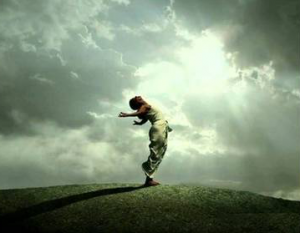
Credit: Youtube
(Continued from Part 1.)
Shankara offers us a definition that sees the longing not as a desire to return home or as an inextinguisable flame lighting the way but as the unquenchable desire to break free from the chains of ignorance. He says:
“[The] Longing for Liberation – is the will to be free from the fetters forged by ignorance — beginning with the ego-sense and so on, down to the physical body itself — through the realization of one’s true nature.” (1)
Notice the focus on the push of the will rather than the pull of desire. Notice also freedom from ignorance rather than freedom from desire. If “I want” is the problem for classical sages, Shankara focuses on ignorance of the “I.”
Like Shankara, Adyashanti calls it an “impulse to be free” and says of it:
“The impulse to be free is an evolutionary spark within consciousness which originates beyond the ego. It is an impulse toward the divine, unity, and wholeness. It is an impulse originating from the Truth itself.” (2)
He goes on to call it “an inner pressure to evolve”:
“The impulse is an inner pressure to evolve, to become whole, to be free. It comes from your true nature, your already-present divinity.” (3)
The spirit guide White Eagle sees it as Adya does, as an “innate urge to grow”:
“One supreme factor helps man along his path … his innate urge to grow. Just as the seed in the ground puts forth its roots and struggles upward through the dark soil to the light, so also man works, at first unconsciously; he does not know what he is doing. Nevertheless, consciously or unconsciously he reaches ceaselessly towards an expansion of consciousness.” (4)
So to these sages, on and off planet, the longing for liberation is an impulse to grow, evolve, and be free. For some it’s an exertion of will and for others an inner impulse.
I could go on citing the different ways that sages have seen the longing for liberation. But I’ve said enough to show that the sages can be shown to approach the task of defining the longing from different angles.
Their views are therefore partial (as all views are). It might be useful to combine them.
What we arrive at may be something like this. The longing for liberation is:
- An evolutionary spark within consciousness which originates beyond the ego.
- An impulse toward the divine, unity, and wholeness, originating from the Truth itself.
- A deep desire and longing to return home to God.
- An unquenchable hope that drives the search to find the way home.
- An inextinguishable Light or Flame that lights the way home.
- The will to be free from the fetters forged by ignorance – beginning with the ego-sense and so on, down to the physical body itself – through the realization of one’s true nature.
- An inner pressure to evolve, an innate urge to grow, to become whole, to be free.
The longing for liberation is a driving impulse, a deep desire, an unquenchable force that spurs us to return home to God.
It’s a spiritual urge and pressure, hope and light that draws us God-ward.
Tracking its rise and releasing its fall serves as a useful homing device, guiding us home.
It’s part and parcel of the soul, of our physical and spiritual DNA, and will only disappear when we merge again with Source.
Whether we see ourselves as drawn by it or spurred on by it, the longing for liberation motivates us to leave separation behind and enter into unity with God, with the One again.
Tomorrow I’d like to look at the way the Company of Heaven recently reinterpreted the longing for liberation.
(Concluded in Part 3.)
Footnotes
(1) Swami Prabhavananda and Christopher lsherwood, Shankara’s Crest-Jewel of Discrimination. Hollywood: Vedanta Press, 1975; c1947, 36.
(2) Adyashanti, The Impact of Awakening. Los Gatos: Open Gate Publishing, 2000, 3.
(3) Loc. cit.
(4) White Eagle, Wisdom from White Eagle. Liss: White Eagle Publishing Trust, 1983. , 92.

